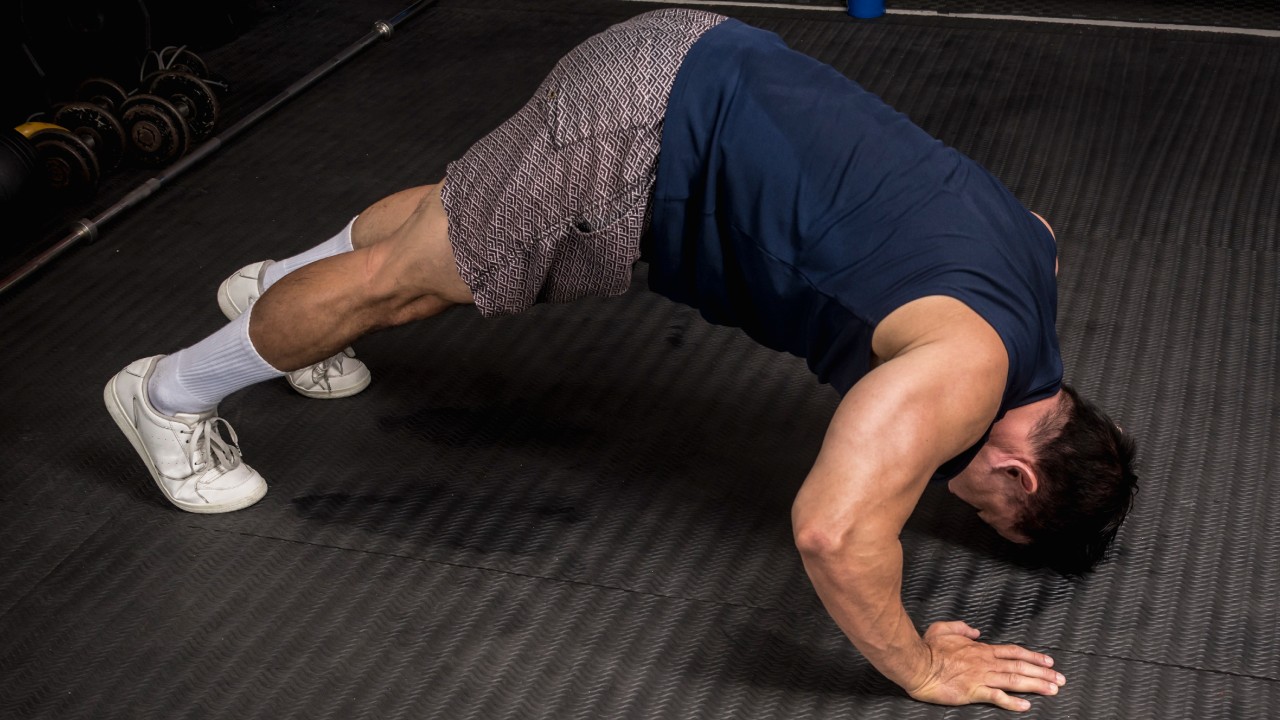
If you’re ready to get serious with your upper-body training but don’t have access to a weights room, the pike push-up is a powerful bodyweight move that can produce major results. While it looks straightforward, don’t underestimate how challenging this workout can be. It’s one of the best shoulder exercises for stability and mobility, but also one that’s easy to get wrong.
“The pike push-up has more in common with a handstand push-up than a regular push-up,” says Cody Mooney, a former CrossFit Games athlete and the director of performance for the mobility and recovery app pliability. “That’s because it’s done in an inverted position. You elevate your hips to create a triangle. This shifts the muscle engagement from your chest and triceps to your front delts. With the pike push-up, you can build a lot of strength within your shoulder joint, but you also put it at risk of injury.”
The pike push-up is not easy, but with the right approach, it can be a great tool for building mass and strength in your upper body. Here is everything you need to know about how to perform this exercise safely and effectively.
Which muscles does the pike push-up work?
The pike push-up targets several muscle groups in the upper body, including your triceps and upper chest muscles, but it is particularly effective at sculpting impressive shoulders for two reasons. It engages the front and middle deltoid heads and, depending on your position, it can also target them individually.
“The pike push-up is generally more focused towards the front side of the delts, but it depends on how high your hips are,” says Mitch Raynsford, a certified strength and conditioning coach at digital fitness coaching platform P3RFORM. “If you have greater mobility and longer hamstrings, you’re going to be able to lift your hips higher. This way you can focus more on your middle delts.”
In addition, the pike push-up will engage a number of stabilizing muscles, including your biceps, lats and the serratus anterior, a small muscle that sits on top of the rib cage and below the armpits. You can also expect considerable core engagement, particularly from your obliques and deep core muscles, such as the transverse abdominis.
Pike Push-Up Benefits
When doing the pike push-up, your shoulders, arms and chest drive the movement, but it’s down to your back and core to hold you securely in place. As a result, this exercise is a great choice for developing body awareness, co-ordination and stability. It is particularly favored by calisthenic athletes, because it helps with developing functional movement patterns needed in more complex exercises. “Practicing pike push-ups allows you to step toward a handstand push-up. It’s a perfect intermediate exercise to teach you how to get yourself into the upright position and hold your bodyweight overhead,” says Raynsford.
The pike push-up can also help to prevent back pain and postural imbalances. The inverted position places significant stress on your spine, which forces your body to activate various stabilizing muscles in your trunk. This in turn translates into a stronger, more functional core.
Pike Push-Up Risks
The pike push-up is not for beginners. Even if you’re an advanced exerciser who has mastered the regular push-up, you may find this exercise challenging. Before attempting the pike push-up, make sure you have sufficient upper-body strength and mobility, or you’ll put yourself in a position where the risk outweighs the benefits. You can easily find movements that target the same muscles but are much safer, says Don Saladino, a celebrity personal trainer and Lumen ambassador.
“If I walk into a class where they’re trying to demonstrate a pike push-up, I bet 80% of participants would not be able to perform this exercise correctly,” says Saladino. “You have to possess a certain level of shoulder mobility, hamstring flexibility and core strength to be able to get into that inverted position, and move your body through the whole range of motion. Otherwise, the juice isn’t worth the squeeze.”
Sign up for workout ideas, training advice, reviews of the latest gear and more.
So, what’s the best alternative? “If someone is unable to perform a pike push-up, I would advise them to get really good at the plank and the regular push-up. The farmer’s carry is another good option,” says Saladino.
Moreover, people prone to dizziness, vertigo or those with very low blood pressure may find this exercise difficult. “When you’re upside down with your head on the floor and your hips higher up, there will be a rush of blood to the head. If you do have issues with blood pressure, always talk to your doctor first. You may need to avoid this inverted position altogether, or try to ease into it slowly and gradually, for example by doing decline push-ups first,” says Raynsford.
Understandably, the pike push-up is also not suitable for those battling wrist, elbow and shoulder injuries. “If you do have any pre-existing injuries, speak to a physiotherapist or sports therapist first. Once you are signed off, you can start including more advanced exercises like the pike push-up,” says Raynsford.
How To Do The Pike Push-Up
The pike push-up can be performed at home without any equipment, but it will help if you have a comfortable mat to work on. To do a pike push-up, start on all fours. With your torso parallel to the mat, press your hands and toes firmly into the floor. Tighten your core, lower back, glute and hamstrings muscles. “Core engagement is crucial with this exercise, so make sure you’re braced throughout the movement,” says Raynsford.
Straighten your legs and lift your hips until your body forms an inverted V shape. Bend your elbows, making sure they stay close to your body throughout the movement, to slowly lower your head toward the floor. Once your head is just above the floor, pause for a second, then straighten up your arms to return to the starting position.
“Remember that the pike push-up gets harder the more you elevate your hips,” says Mooney. “If you struggle to achieve a full range of motion, you can either get the hips a little bit lower, or put a cushion or a box on the floor, so you don’t have to go quite as far.”
Pike Push-Up Form Tips

1. Don’t Round Your Back
What Make sure your back is straight throughout the movement.
Why A rounded back increases the pressure on your shoulders and traps, which puts you at risk of strain and injury.
How Keep your core muscles engaged throughout the exercise. To do this, imagine that someone is about to punch you in the stomach. If your core is engaged, but your back is still rounded, that may mean your core is too weak or your lower back lacks sufficient mobility. In order to master your pike push-up stance, you may need to begin by strengthening your deep core muscles (for example, by practicing planks) and increasing the range of movement in your lumbar spine (yoga and Pilates can help with this).
2. Control Your Descent
What Don’t rely on momentum when bringing your upper body toward the floor.
Why If you don’t control momentum, you fail to engage the muscles in your arms and upper back. This will not activate the correct muscles and will take away a lot of stability from your shoulder and elbow joints. This in turn creates ideal conditions for a painful injury.
How Don’t rush! Perform each repetition in a slow and controlled manner by lowering your body for a count of five.
3. Don’t Flare Your Elbows
What Keep your elbows tucked in to your sides at a 45° angle.
Why “By tucking your elbows in, you’ll be able to retract the shoulder blades and reduce the pressure on your traps. This allows you to better recruit your shoulder muscles,” says Raynsford.
How Try one of Mooney’s favorite cues, “Imagine your hands on a piece of paper and as you go down, try to rip it apart. It will allow you to drive your elbows in,” says Mooney.
4. Modify Your Stance
What Modifying your stance can help you tweak your muscle engagement.
Why and how “If you place your feet too close together, there’s going to be a lot of balance work involved,” says Raynsford. “So, a narrow stance may be more advantageous if you want to challenge your core. If you’re looking to increase your shoulder strength, a wider stance may be better.”
Pike Push-Up Vs Push-Up
In theory, the pike push-up is a variation of the regular push-up. However, these two movements have more differences than similarities.
To start with, the pike push-up requires far more upper-body strength and mobility than the standard push-up, especially when performed for high-volume sets. They also target slightly different muscle groups. “Regular push-ups are a lot more chest-dominant than pike push-ups, and they may also require more triceps engagement,” says Mooney. “Pike push-ups, on the other hand, focus more on the shoulders.”
In addition, the regular push-up is often viewed as a stepping stone to the bench press and other weighted chest exercises. The pike push-up, on the other hand, is often used as a transition exercise to more complex bodyweight movements, such as the handstand push-up. “The inverted position places way more stress on the shoulder than the plank position. It’s mimicking the upright position typical of many advanced calisthenics exercises,” says Mooney.
About Our Experts

Cody Mooney is the director of performance for the mobility and recovery app pliability. Cody started doing CrossFit when he was 15, and became a coach at his local gym at 16. After deciding to pursue a career in CrossFit, he became a two-time CrossFit Games athlete in 2019, and was part of the second fittest team in the world.

Mitch Raynsford is a certified personal trainer, UKSCA-accredited S&C coach, and the lead strength and conditioning coach at digital fitness coaching platform P3RFORM. He holds a MSc degree in Sports Science and Applied Sports Physiology from the University of Brighton. Mitch has worked for Aston Villa Women football club as the lead trainer preparing players for a return to competitive matches, and also took on the role of sports scientist with the senior squad.

Don Saladino has trained celebrities including Ryan Reynolds, John Krasinski and Blake Lively, and has appeared on the cover of Muscle & Fitness magazine twice. He is NASM-certified and opened the New York City gym Drive 495 in 2005.

Anna Gora is a health writer and certified PT with more than a decade’s experience in the fitness industry. She provides online health coaching to people as part of the UK’s Healthier You: NHS Diabetes Prevention Programme and has a master’s degree in Nutrition, Physical Activity & Public Health from the University of Bristol. As well as Coach, Anna also contributes to sister site Fit&Well and science news website Live Science.
